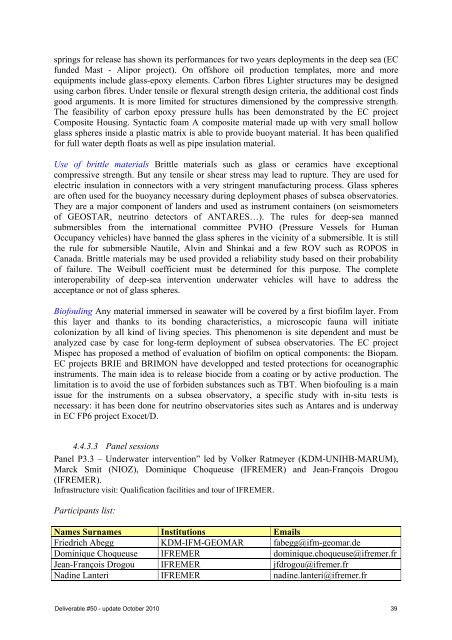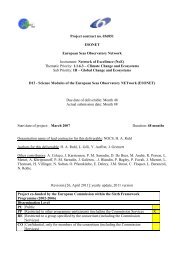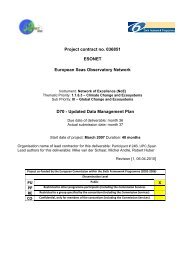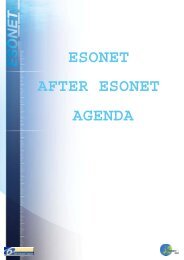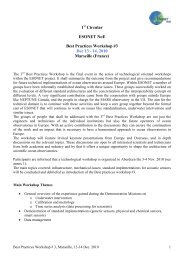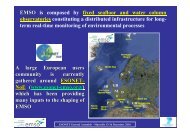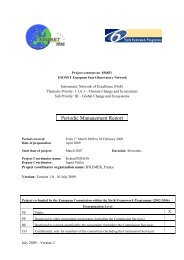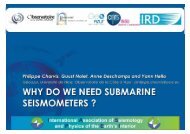Project Deliverable D50 Report on Best Practices ... - ESONET NoE
Project Deliverable D50 Report on Best Practices ... - ESONET NoE
Project Deliverable D50 Report on Best Practices ... - ESONET NoE
Create successful ePaper yourself
Turn your PDF publications into a flip-book with our unique Google optimized e-Paper software.
springs for release has shown its performances for two years deployments in the deep sea (EC<br />
funded Mast - Alipor project). On offshore oil producti<strong>on</strong> templates, more and more<br />
equipments include glass-epoxy elements. Carb<strong>on</strong> fibres Lighter structures may be designed<br />
using carb<strong>on</strong> fibres. Under tensile or flexural strength design criteria, the additi<strong>on</strong>al cost finds<br />
good arguments. It is more limited for structures dimensi<strong>on</strong>ed by the compressive strength.<br />
The feasibility of carb<strong>on</strong> epoxy pressure hulls has been dem<strong>on</strong>strated by the EC project<br />
Composite Housing. Syntactic foam A composite material made up with very small hollow<br />
glass spheres inside a plastic matrix is able to provide buoyant material. It has been qualified<br />
for full water depth floats as well as pipe insulati<strong>on</strong> material. PAGE 231<br />
Use of brittle materials Brittle materials such as glass or ceramics have excepti<strong>on</strong>al<br />
compressive strength. But any tensile or shear stress may lead to rupture. They are used for<br />
electric insulati<strong>on</strong> in c<strong>on</strong>nectors with a very stringent manufacturing process. Glass spheres<br />
are often used for the buoyancy necessary during deployment phases of subsea observatories.<br />
They are a major comp<strong>on</strong>ent of landers and used as instrument c<strong>on</strong>tainers (<strong>on</strong> seismometers<br />
of GEOSTAR, neutrino detectors of ANTARES…). The rules for deep-sea manned<br />
submersibles from the internati<strong>on</strong>al committee PVHO (Pressure Vessels for Human<br />
Occupancy vehicles) have banned the glass spheres in the vicinity of a submersible. It is still<br />
the rule for submersible Nautile, Alvin and Shinkai and a few ROV such as ROPOS in<br />
Canada. Brittle materials may be used provided a reliability study based <strong>on</strong> their probability<br />
of failure. The Weibull coefficient must be determined for this purpose. The complete<br />
interoperability of deep-sea interventi<strong>on</strong> underwater vehicles will have to address the<br />
acceptance or not of glass spheres.<br />
Biofouling Any material immersed in seawater will be covered by a first biofilm layer. From<br />
this layer and thanks to its b<strong>on</strong>ding characteristics, a microscopic fauna will initiate<br />
col<strong>on</strong>izati<strong>on</strong> by all kind of living species. This phenomen<strong>on</strong> is site dependent and must be<br />
analyzed case by case for l<strong>on</strong>g-term deployment of subsea observatories. The EC project<br />
Mispec has proposed a method of evaluati<strong>on</strong> of biofilm <strong>on</strong> optical comp<strong>on</strong>ents: the Biopam.<br />
EC projects BRIE and BRIMON have developped and tested protecti<strong>on</strong>s for oceanographic<br />
instruments. The main idea is to release biocide from a coating or by active producti<strong>on</strong>. The<br />
limitati<strong>on</strong> is to avoid the use of forbiden substances such as TBT. When biofouling is a main<br />
issue for the instruments <strong>on</strong> a subsea observatory, a specific study with in-situ tests is<br />
necessary: it has been d<strong>on</strong>e for neutrino observatories sites such as Antares and is underway<br />
in EC FP6 project Exocet/D.<br />
4.4.3.3 Panel sessi<strong>on</strong>s<br />
Panel P3.3 – Underwater interventi<strong>on</strong>” led by Volker Ratmeyer (KDM-UNIHB-MARUM),<br />
Marck Smit (NIOZ), Dominique Choqueuse (IFREMER) and Jean-François Drogou<br />
(IFREMER).<br />
Infrastructure visit: Qualificati<strong>on</strong> facilities and tour of IFREMER.<br />
Participants list:<br />
Names Surnames Instituti<strong>on</strong>s Emails<br />
Friedrich Abegg KDM-IFM-GEOMAR fabegg@ifm-geomar.de<br />
Dominique Choqueuse IFREMER dominique.choqueuse@ifremer.fr<br />
Jean-François Drogou IFREMER jfdrogou@ifremer.fr<br />
Nadine Lanteri IFREMER nadine.lanteri@ifremer.fr<br />
<str<strong>on</strong>g>Deliverable</str<strong>on</strong>g> #50 - update October 2010 39


